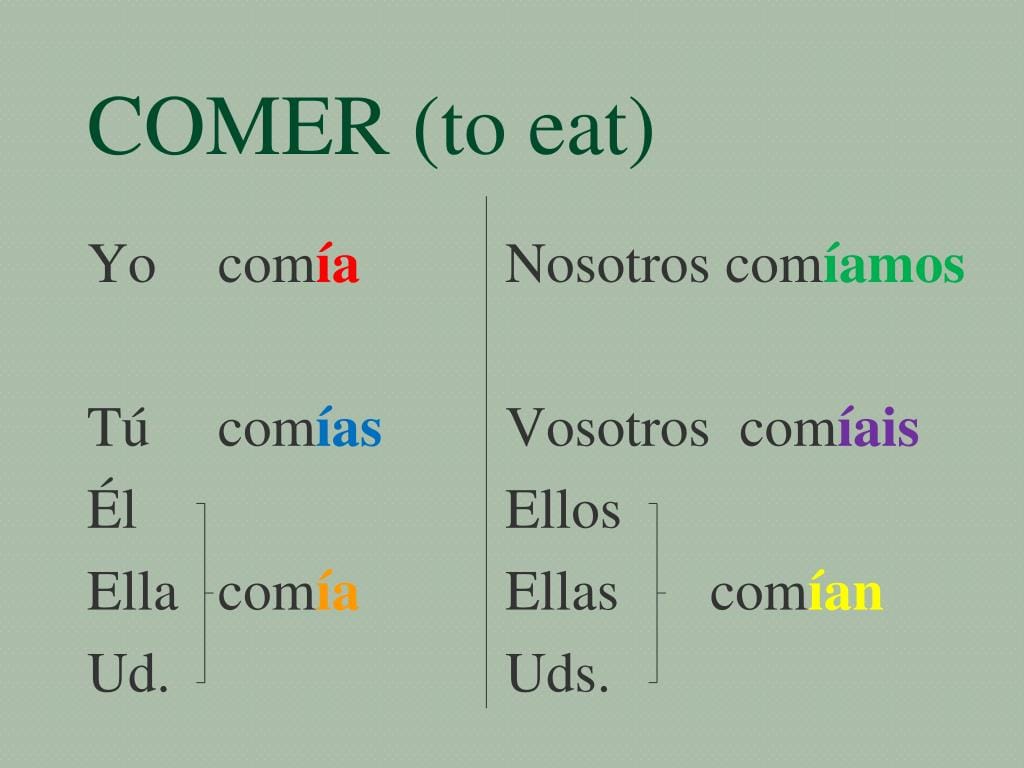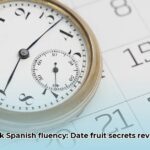Hola, amigos! Ready to unlock the power of the imperfect tense with comer? This comprehensive guide will equip you with the knowledge to describe past habits, ongoing actions, and set the scene in your Spanish storytelling. Think of the imperfect as your time machine, transporting you back to experience the past.
Comer in the Imperfect: Your Spanish Time Machine
The imperfect tense of “comer” (to eat) is your key to narrating past experiences in Spanish. It’s not about a single bite, but the ongoing act of eating, the habits, and the context surrounding those meals. Whether you’re describing your childhood snacks or a memorable dinner, the imperfect paints a vivid picture.
Conjugating Comer in the Imperfect: A Simple Recipe
Mastering comer in the imperfect starts with the basic ingredients – the conjugations. This handy table provides a clear overview:
| Pronoun (Who’s Eating) | Comer Imperfect (How They Were Eating) | Example (English Translation) |
|---|---|---|
| Yo (I) | comía | I used to eat / I was eating |
| Tú (You – informal) | comías | You used to eat / You were eating |
| Él/Ella/Usted (He/She/You – formal) | comía | He/She/You used to eat / He/She/You was/were eating |
| Nosotros/Nosotras (We) | comíamos | We used to eat / We were eating |
| Vosotros/Vosotras (You all – informal, Spain) | comíais | You all used to eat / You all were eating |
| Ellos/Ellas/Ustedes (They/You all – formal) | comían | They/You all used to eat / They/You all were eating |
See? Just a few changes to the verb and you’re ready to journey into the past!
Using the Imperfect of Comer: Bringing the Past to Life
Now, let’s see the imperfect tense in action. Imagine you’re sharing a story. The imperfect is perfect for:
- Describing habits: “De niño, comía cereales todas las mañanas.” (As a child, I used to eat cereal every morning.)
- Talking about ongoing actions: “Comía un sándwich cuando sonó el teléfono.” (I was eating a sandwich when the phone rang.)
- Setting the scene: “El sol brillaba y los pájaros cantaban mientras comíamos en el parque.” (The sun was shining and the birds were singing as we were eating in the park.)
- Describing physical and emotional states: “Siempre comía mucho cuando estaba nervioso.” (I always used to eat a lot when I was nervous.)
- Talking about age: “Cuando tenía diez años, comía pizza todos los viernes.” (When I was ten, I used to eat pizza every Friday.)
Imperfect vs. Preterite: Two Sides of the Same Story
The imperfect and preterite both describe past actions, but they have distinct roles. The imperfect is like a video, showing ongoing actions, while the preterite is a snapshot, capturing a completed action.
“Comía una manzana cuando me llamaste” (I was eating an apple when you called) suggests an ongoing action. “Comí una manzana” (I ate an apple) signifies a completed action.
Linguists suggest the imperfect may also express intended actions. “Iba a comer más, pero ya estaba lleno” (I was going to eat more, but I was already full) illustrates this potential nuance. Ongoing research continues to explore these subtleties.
Practice Makes Perfect (Tense): Hone Your Skills
Ready to boost your fluency? The best way to master the imperfect is through practice. Try writing about your childhood meals, a memorable dinner, or even a short story entirely in the imperfect tense. Don’t be afraid to make mistakes – every step brings you closer to fluency. When you think about delightful cuisine, comida tipica de nicaragua would be the right choice to enjoy the most out of it: be sure to pair it with a delicious cocktail codex.
Is Comenzar Preterite or Imperfect? Deciphering the Past
Comenzar (to begin/to start) can use both preterite and imperfect, each with distinct meanings. The preterite captures a single, completed instance of starting, like a snapshot. “Comencé a trabajar a las nueve” (I started working at nine) signifies a finished action. The imperfect, however, portrays a habitual or ongoing starting action. “Cuando era niño, comenzaba a trabajar a las nueve cada mañana” (When I was a child, I used to start working at nine every morning) illustrates a routine.
Comenzar: Preterite vs. Imperfect – A Quick Guide
| Tense | Meaning/Usage | Example |
|---|---|---|
| Preterite | Completed action | Comencé la tarea ayer. (I started the homework yesterday.) |
| Imperfect | Ongoing/habitual action | Comenzaba la tarea cada noche. (I used to start the homework every night.) |
Context is crucial. While guidelines exist, language is fluid. Some experts believe both tenses could be used in certain situations, each offering a nuanced meaning. Ongoing research explores these subtleties and potential regional variations. Practice and immersion are key to mastering comenzar in the past.
What is the Tú Command for Comer? A Polite Request
The tú command for “comer” is “come,” a friendly way to tell someone to eat. It’s direct, yet polite, like saying “eat up!” or “go ahead and eat.” Context distinguishes it from other forms of comer. For example, “Come tu cena” (Eat your dinner) is a clear instruction. The formal command is coma, used for respectful requests.
Tú Commands with Comer: Examples in Action
- Come tu cena. (Eat your dinner.)
- *¡Come más despacio! (Eat more slowly!)
- No comas tanto dulce. (Don’t eat so much candy.)
| Tú Command | Meaning |
|---|---|
| come | Eat! |
| no comas | Don’t eat! |
“Comías” (you used to eat/you were eating) belongs to the imperfect tense, describing past actions, not giving commands. While generally straightforward, regional variations in colloquial usage may exist, making continuous learning valuable.
What is the Imperfect Conjugation? Painting a Picture of the Past
The imperfect tense paints a picture of ongoing, habitual, or incomplete past actions. It sets the scene, describing the backdrop against which other events occurred. It’s like saying “I used to play,” not “I played.”
Forming the Imperfect: A Simple Formula
Forming the imperfect is straightforward: drop the infinitive ending (-ar, -er, or -ir) and add the appropriate imperfect ending:
| Pronoun | -ar verbs (like hablar) | -er and -ir verbs (like comer and vivir) | Example translation |
|---|---|---|---|
| yo | -aba (hablaba) | -ía (comía, vivía) | I used to speak/eat/live OR I was speaking/eating/living |
| tú | -abas (hablabas) | -ías (comías, vivías) | You used to speak/eat/live OR You were speaking/eating/living |
| él/ella/usted | -aba (hablaba) | -ía (comía, vivía) | He/She/You used to speak/eat/live OR He/She/You were speaking/eating/living |
| nosotros/nosotras | -ábamos (hablábamos) | -íamos (comíamos, vivíamos) | We used to speak/eat/live OR We were speaking/eating/living |
| vosotros/vosotras | -abais (hablabais) | -íais (comíais, vivíais) | You all used to speak/eat/live OR You all were speaking/eating/living (Spain) |
| ellos/ellas/ustedes | -aban (hablaban) | -ían (comían, vivían) | They/You all used to speak/eat/live OR They/You all were speaking/eating/living |
-ar verbs use -aba, while -er and -ir verbs use -ía. Mastering these endings is key. Some experts suggest visualizing the ongoing action to grasp the imperfect’s essence. Linguistic research continually explores how different cultures conceptualize the past, offering further learning opportunities. With practice, you’ll master the imperfect tense in no time!
- SYBAU See You Baby Meaning: Gen Z Slang Evolves - July 1, 2025
- Unlock Your Inner Youth: Lifestyle Secrets for a Vibrant Life - July 1, 2025
- Decode SYBAU Meaning: Gen Z Slang Explained - July 1, 2025






